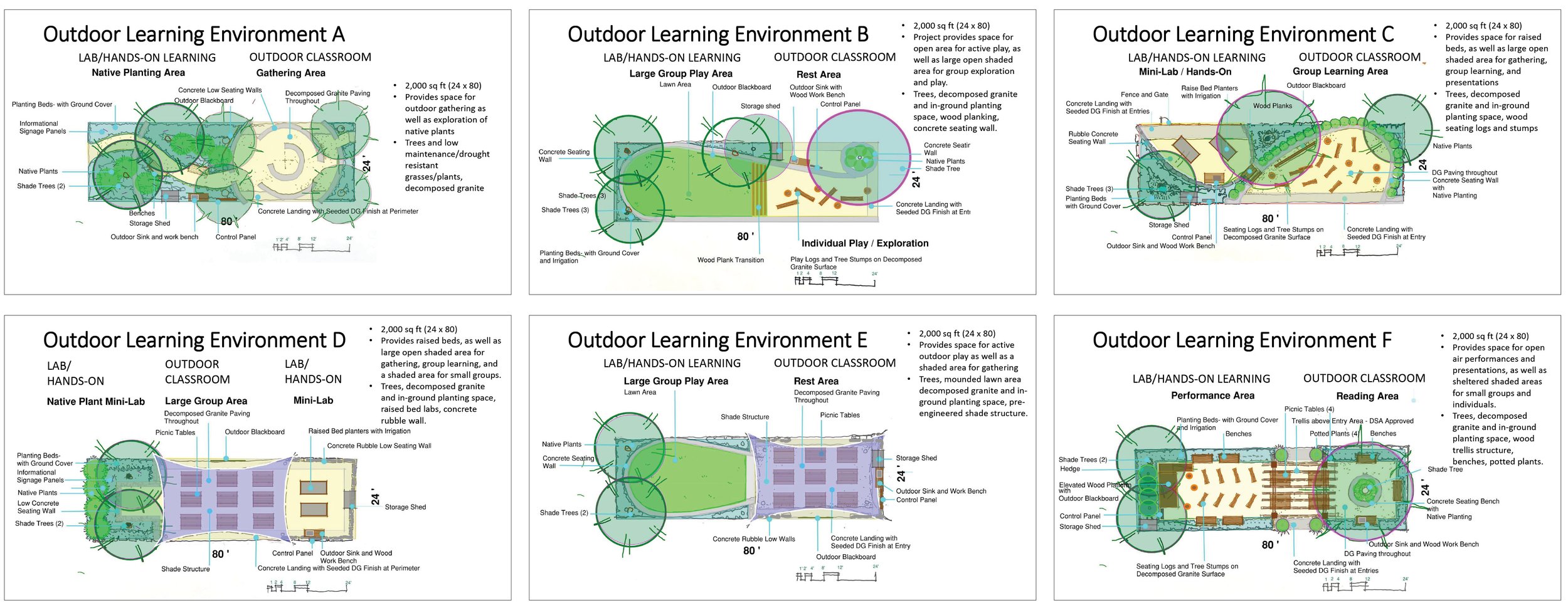Berliner Architects is currently working on the Design Guidelines for Los Angeles Unified School District’s Outdoor Learning Environments.
LAUSD already has a number of Outdoor Learning Environments on their campuses, though not all have the right furniture, fixtures, equipment, or landscaping to function properly as classrooms.
At the start of the process, we reviewed documents provided by LAUSD that outlined Lessons Learned from the installation of previous Outdoor Learning Environments and the district’s best practices.
We then visited existing LAUSD Outdoor Learning Environments and were able to see first-hand what worked and did not work for the District. We visited Carthay Elementary School and Eagle Rock Elementary School in November 2022 and spoke with the staff and administrators at the schools about their OLE’s.
Eagle Rock Elementary
Carthay Elementary School
From these site visits, we determined a number of Must Haves and Nice to Haves for the new design guidelines:
Must Haves:
Critical to have information on underground utilities ahead of time
Large high-value shade trees need substantial rootzone areas to provide substantial shade. Avoid utility conflicts which can limit available rootzones and potential locations for planting
General Shade (Natural and/or Man-made)
Storage
Hand Watering
Quick couplers are not used by staff. A hose bibb with removable handle or in locked box would be preferable
Pavers are a good solution for permeable pavements
Proximity to existing buildings
Clear lines of sight into the OLE from other parts of the yard
Durable irrigation systems and localized controls
Low maintenance plantings for shade and curriculum resources
Table and Seats with shade
Less distraction / Noise
Large introductory information panel
Power and data, access to school wi-fi network
Confirm ability to hear school PA, Fire Alarm, and School Bell and that minimum Db levels are met.
ADA accessible Path of Travel and access to: washrooms, water fountains, and beyond to the main administration office, and parking areas.
Nice to Haves:
Black Board and storage; storage is required to have resources readily available
High Table for teachers to use as demonstration would be great
Providing Steppingstones for kids would be nice for both areas of DG or planting while conforming to ADA access somehow.
Provide elements for self-directed activities as opposed to instruction only activities, kids like to dig, build and play in outdoor classroom and gardens independently
Lower stumps and logs placed closer together for kids to play on safely
Work/ demonstration bench with sink, and connections to nearby water supply and drainage.
Site Evaluations
We developed a Site Planning Matrix to help schools determine the best sites for their new Outdoor Learning Environments. The Site Planning Matrix is to be used at the beginning of the site selection phase by the entire design team, including the LAUSD project manager, the architect of record, and the landscape architect. The process should be explained to the school’s stakeholder group and this group should be part of the discussion around the “initial site selection” process. It is advised that between 5-10 sites be initially selected per Greening Index to go through the evaluation process to weigh the pros and cons of each site and select the most appropriate site that will meet the goals of the program.
The design team shall go through each category and assign a weighted point value for each category per site, with 10 being the highest. The highest score a site can get is 90 points. In certain instances, a score of 0 can nullify a site, such as if the site contains a fire lane or is potentially impassible, hazardous, or cost prohibitive. The design team should use their judgment during the initial site selection to limit the possibilities to only viable sites.
The matrix table should be filled out and shared with the stakeholder group for discussion. Only the sites in the top three top point values should be considered for selection and nominated for final approval.
Site Planning Matrix Criteria
Fire Lanes/Circulation Disruption
Path Of Travel/Restroom Access
Adjacency To Buildings/Classrooms
Visibility To Ole
Existing Shade
Acoustics/Adjacency To Noise
Utilities Power/ Data/Water/Irrigation
Soils Analysis/Permeability
Removing Portables
LAUSD Concept Classrooms
LAUSD had developed preliminary concept classroom designs exploring potential different uses and designed to fit within the footprint of a removed portable classroom. The concept classroom designs were created with the idea that the OLEs would replace existing portable classrooms on campus and be comprised of two or three distinct areas within the site. With this concept in mind, we developed six classroom types that could be chosen based on the individual school’s curriculum and needs, each with variations that could be combined with a service connector to create a variety of OLEs.
Classroom Types
There are six classroom types and a service connector that can be combined into a multitude of outdoor learning environments:
Service Connector
Type “A” Outdoor Classroom - Group Learning Area
Type “B” Outdoor Classroom - Performance Area
Type “C” Learning Lab - Habitat Planting Area
Type “D” Learning Lab - Raised Planter Area
Type “E” Learning Lab - Micro Forest
Type “F” Learning Lab - Active Play Area
Service Connector
The Service Connector joins the different learning environments providing centralized utilities including power, data, and irrigation controls. Each connector also has a storage space and an island counter with two sinks where students can gather for demonstrations.
Type “A” - Outdoor Classroom - Group Learning Area
The Group Learning Area is an outdoor learning environment where students can collectively gather and learn in a classroom or collaborate in smaller groups surrounded by a natural, planted backdrop. The Group Learning Area is set upon a durable and permeable surface and is shaded (via a shade canopy or natural trees), facilitating year-round use. The Outdoor Classroom is fully equipped with Wi-Fi, electrical outlets, a blackboard, and nearby storage.
The Group Learning Area accommodates seating for up to 32 students.
The learning environments can be configured in different ways depending on the specifics of the site and the landscape aesthetics. The square-shaped spaces are a diagrammatic model for how to layout the spaces but these examples demonstrate how the model can be manipulated but still provide the required program elements.
Type “B” - Outdoor Classroom - Performance Area
The Performance Area offers an outdoor learning environment for student performances and presentations within a natural setting. This space also includes natural log seating and a chalkboard to facilitate its use as an outdoor classroom. The incorporation of Wi-Fi, electrical outlets, and nearby storage allows for further flexibility of use. The space is surrounded by plantings and trees, and an optional shade structure to maximize year-round use.
The Performance Area accommodates seating for up to 32 students.
Type “C” - Learning Lab - Habitat Planting Area
The Habitat Planting Area offers a hands-on learning lab experience where students can explore and observe plants, animals, and insects within a representative habitat type. This green education space provides an environment that supports a variety of habitats, such as native or pollinator.
Type “D” - Learning Lab - Raised Planted Area
The Raised Planter Area offers a hands-on learning lab experience where students can explore and tend to curriculum-selected plants within raised planted boxes. the raised planter area is surrounded by and in-ground habitat planting area that provides an additional learning environment.
Type “E” - Learning Lab - Micro Forest
The Micro Forest is an outdoor learning environment that encourages habitat exploration within an area that is densely planted with a variety of trees and plants. carious seating is provided within the Micro Forest to support its use as a peaceful reading area or as a space for quiet reflection.
Type “F” - Learning Lab - Active Play Area
The Active Play Area offers an outdoor learning environment where students can actively engage with the natural environment through physical play and exploration. This green space encourages student movement, as well as informal, small group gatherings within a natural setting.
Combinations
The templates are designed so that they can all be combined with the Service Connector, which houses essentials like the sink and storage shed, to create multi-purpose Outdoor Learning Environments that fit the selected sites and school’s needs.



















